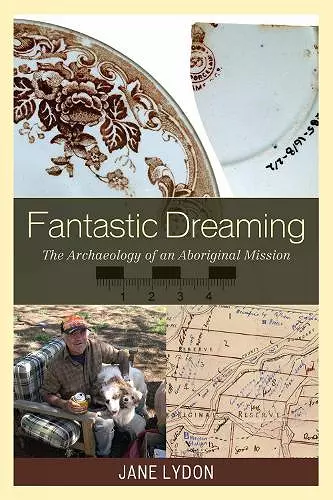Fantastic Dreaming
The Archaeology of an Aboriginal Mission
Format:Hardback
Publisher:AltaMira Press
Published:16th Nov '09
Currently unavailable, and unfortunately no date known when it will be back
This hardback is available in another edition too:
- Paperback£46.00(9780759111059)

Fantastic Dreaming explores how whites have measured Australian Aboriginal people through their material culture and domestic practices, aspects of culture intimately linked to Enlightenment notions of progress and social institutions such as marriage and property. Archaeological investigation reveals that the Moravian missionaries' attempts to "civilize" the Wergaia-speaking people of northwestern Victoria centered on spatial practices, housing, and the consumption of material goods. After the mission closed in 1904, white observers saw the camp settlements that formed nearby as evidence of Aboriginal incapacity and immorality, rather than as symptoms of exclusion and poverty. Conceptions of transformation as acculturation survived in assimilation policies that envisioned Aboriginal people becoming the same as whites through living in European housing. These ideas persist in archaeological analysis that insists on Aboriginality as otherness and difference, and equates objects with identity. However Wergaia tradition was place-based, and, often invisibly, Indigenous people maintained traditional relationships to kin and country, resisting white authority through strategies of evasion and mobility. This study examines the complex role of material culture and spatial politics in shaping colonial identities and offers a critique of essentialism in archaeological interpretation.
Some of the first physical traces left in the Victorian landscape by European settlers were those of Major Thomas Mitchell’s dray as it passed through the soft earth and left tracks that remained visible for years. As a slowly fading image of the passing of people and animals through country it is a powerful one that remains in the imagination of the reader throughout this book. Soft footed wallabies and bare footed humans had never before left permanent tracks in the sandy soil such as these. ... There are many fascinating insights into the mission as a place of exchange of culture provided by this book. This is set within a wider context of both secular and religious thought and writings of the late eighteenth and nineteenth century. Fantastic Dreaming sets out to explore many things and it does so in a scholarly fashion. The endnotes to each chapter are extensive and illuminating, and the range of sources are extensive, representing a wide range of views. The strength of the book comes from Lydon’s own intimate knowledge of the place through archeological surveys and through talking to Aboriginal people descended from those who lived at Ebenezer. * Historic Environment *
This is indeed a 'fantastic' book, full of the sort of rich 'hidden' histories that connect the past with the present. It represents the sort of richly longitudinal study which we need in Australasian archaeology, and I congratulate AltaMira Press and the World of Archaeology Series Editors on commissioning this important book. . . . This rich and deeply nuanced analysis of the role of material culture and spatial politics in shaping colonial identities and archaeology's potential in illuminating hidden colonial pasts in a postcolonial present deserves a place on the bookshelves of all Australians, and will appeal to anyone with an interest in how the past matters in the present. * Australasian Historical Archaeology *
Fantastic Dreaming is well-written and provides a comprehensive and rich spatial history of the Ebenezer mission. It presents many historical photographs and reproduces important sketch maps. Lydon successfully interrogates the marginal status of the Wergaia in regional Victorian towns, such as Antwerp and Dimboola, in the twentieth century and reveals how disparaging comments from non-Aboriginal houses were blind to the long term, if intangible, attachment of Aboriginal people to their places. * Aboriginal History *
Jane Lydon has written a very important book, which accentuates the importance of modern Aboriginal cultural heritage. . . . Lydon's Fantastic Dreaming stands as a remarkable book on the cultural transformations and continuity surrounding missions. I warmly recommend this book as a fantastic and stirring story which sets a necessary standard for future research in humanities. * Archaeology In Oceania *
Jane Lydon's Fantastic Dreaming is a scholarly work that bears the hallmarks of this researcher as someone engaged with theory, and skilled in the interpretation of multiple sources….And not least of all it provides a detailed insight into the history of Victorian missions. * Australian Archaeology, June 2011 *
This book adds another layer to our increasing understanding of the nuances and subtleties of culture contact and colonialism in all its guises. Lydon provides an account of mission society that is rich in detail and profound in sensitivity. Archaeologists would be wise to emulate her exhaustive research program and her multiscalar, multicultural perspective. She sets a high standard for historical archaeology. -- Charles E. Orser Jr., Vanderbilt University
Lydon's Fantastic Dreaming represents an important contribution to our understanding of the complexities of cross-cultural exchange in Australian history. Focused on the mission site of Ebenezer in Victoria, Lydon skillfully weaves a story of transformation and persistence that is grounded in a deep engagement with the place, its people, and material culture recovered through survey and excavation. Significantly, Lydon's story acknowledges the importance of Ebenezer to those whose lives it has touched in so many ways, and it provides an exemplar of how researchers and indigenous people can together create compelling history. -- Timothy Murray, La Trobe University
- Winner of The Australasian Society of Historical Archaeology's Graham Connah Book Award, 2014 2014
- Winner of The Australian Archaeological Association's John Mulvaney Book Award Winner 2010.
ISBN: 9780759111042
Dimensions: 239mm x 162mm x 25mm
Weight: 667g
330 pages